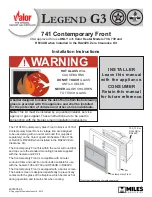
53D0419
Designer Series Gas Fireplaces
VENTING INSTaLLaTIoN
FLaT CEILING INSTaLLaTIoN
1. Cut a 9
Z\x
" (41 mm) square hole in the ceiling using the
locating hole as a center point The opening should be
framed to 9
Z\x
" x 9
Z\x
" (41 x 41 mm) inside dimensions
as shown in
Figure 34
using framing lumber the same
size as the ceiling joist. If the area above the ceiling is
an insulated ceiling or a room, nail firestop from the top
side. This prevents loose insulation from falling into the
required clearance space.
Figure 34.
Otherwise, install
firestop below the framed hole.
. Assemble the desired lengths of pipe and elbows nec-
essary to reach from the burner system flue up through
the firestop. Be sure pipe and elbow connections are
fully twist-locked.
Page 18, Figure 19
FP1969
offset w/ wallstrap
Figure 33 -
Offset with Wall Strap and 45° Elbows
Roof
Flashing
Wall Strap
45° Elbows
Ceiling Firstop
FP1669
FP1969
firestop w room above
Figure 34 -
If area above is a room, install firestop above
framed hole as shown
Firestop
Nails
FP1969
9
1
/
2
"
9
1
/
2
"
FP1970
firestop no room
Figure 35 -
If area above is not a room, install firestop below
framed hole as shown
Nails
Firestop
FP1970
3. Cut a hole in the roof using the locating hole as a center
point. (Cover any exposed open vent pipes before cut-
ting hole in roof). The 9
Z\x
" x 9
Z\x
" (41 x 41 mm) hole
must be measured on the horizontal. Actual length may
be larger depending on the pitch of the roof. There must
be a 1" minimum clearance from the vent pipe to com-
bustible materials. (Insulation should be considered a
combustible material) Frame the opening as shown on
Page 18,
Figure 18.
4. Connect a section of pipe and extend up through the
hole.
NoTE: If an offset is needed to avoid obstructions, you
must support the vent pipe every three (3) feet. use
wall straps for this purpose. Refer to
Page 23, Figure
31
. whenever possible, use 45° elbows instead of 90°
elbows. The 45° elbow offers less restriction to the flow
of the flue gases and intake air.
5. Place the flashing over the pipe section(s) extending
through the roof. Secure the base of the flashing to
the roof and framing with roofing nails. Be sure roofing
material overlaps the top edge of the flashing. There
must be a 1" clearance from the vent pipe to combustible
materials.
6. Continue to add pipe sections until the height of the vent
cap meets the minimum building code requirements.
NoTE: you must increase vent height for steep roof
pitches. Nearby trees, adjoining roof lines, steep
pitched roofs, and other similar factors may cause
poor draft or down-drafting in high winds. Increasing
the vent height may solve this problem.
NoTE: If the vent pipe passes through any occupied
areas above the first floor, including storage spaces
and closets, you must enclose pipe. you may frame and
sheetrock the enclosure with standard construction
material. Make sure to meet the minimum allowable
clearances to combustibles. Do not fill any of the
required clearance spaces with insulation.
















































